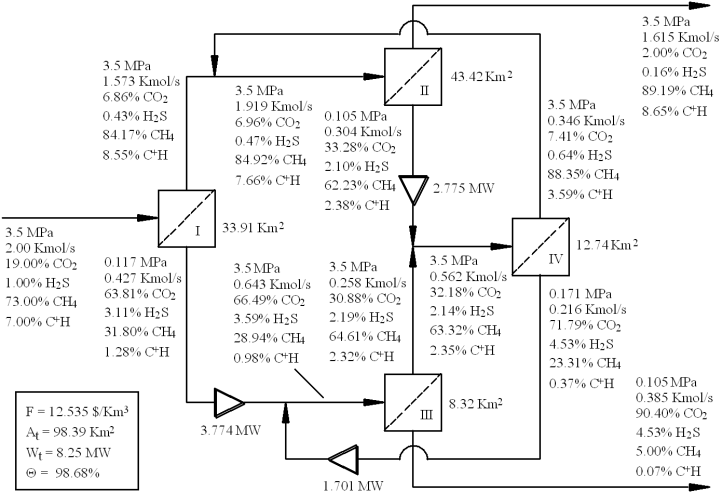Modeling and Optimal Design of Membrane Separation Systems
We developed simplified modeling and optimal design techniques for membrane gas separations systems. Our initial work focused on spiral-wound membrane processes for binary gas separations. A simplified design model was derived from the governing transport equations by assuming that the residue flow rate is approximately constant along the length of the permeator. The simplified model was used to design optimal separation systems consisting of spiral-wound membrane permeators and gas compressors. Both the fixed configuration problem (nonlinear programming) and the variable configuration problem (mixed-integer nonlinear programming) were solved for the separation of binary methane and carbon dioxide mixtures. These modeling and design techniques were extended to multicomponent gas mixtures.
We also developed a differential equation model to simulate the performance of spiral wound membrane modules for the pervaporative separation of binary liquid mixtures. Unknown parameters of the solution-diffusion model are determined from film sorption and flux data using nonlinear least-squares estimation. The solution-diffusion model is coupled to transport equations for the feed-side composition, velocity and temperature and the permeate-side composition, velocity and pressure. The proposed model has been used to simulate spiral wound pervaporation modules for the separation of styrene and ethylbenzene with a polyurethane membrane. The detailed pervaporation model is suitable for evaluating the economic viability of hybrid pervaporation-distillation processes.
Funding: National Science Foundation (CTS-9817298)
Students: Ruhong Qi (Ph.D.) and Bing Cao (Post-Doc)
Collaborator: Dr. Howard Meyer (Gas Technology Institute)
Publications:
- Qi, R. and M. A. Henson, "Approximate Modeling of Spiral-Wound Gas Permeators," Journal of Membrane Science, 121, 11-24 (1996). [PDF]
- 2. Qi, R. and M. A. Henson, "Modeling of Spiral-Wound Permeators for Multicomponent Gas Separations," Industrial Engineering and Chemistry Research, 36, 2320-2331 (1997). [PDF]
- 3. Qi, R. and M. A. Henson, "Optimization-Based Design of Spiral-Wound Membrane Systems for CO2/CH4 Separations," Separation and Purification Technology, 13, 209-225 (1998). [PDF]
- 4. Qi, R. and M. A. Henson, "Optimal Design of Spiral-Wound Membrane Networks for Gas Separations," Journal of Membrane Science, 148, 71-89 (1998). [PDF]
- 5. Qi, R. and M. A. Henson, "Membrane System Design for Multicomponent Gas Mixtures via Mixed-Integer Nonlinear Programming," Computers and Chemical Engineering, 24, 2719-2737 (2000). [PDF]
- 6. Cao, B. and M. A. Henson, "Modeling of Spiral Wound Pervaporation Modules with Application to the Separation of Styrene/Ethlbenzene Mixtures," Journal of Membrane Science, 197, 117-146 (2002). [PDF]
- 7. Cao, B. and M. A. Henson, "Nonlinear Parameter Estimation for Solution-Diffusion Models of Membrane Pervaporation," Annals of the New York Academy of Sciences, 984, 37-385 (2003). [PDF]
- 8. Meyer, Howard S. and M. A. Henson, "Methane Selective Membranes for Nitrogen Removal from Low Quality Natural Gas - High Permeability is Not Enough," Proc. Natural Gas Technologies II: Ingenuity and Innovation, Phoenix, AZ (2004). [PDF]
Optimal Membrane System Design for a Natural Gas Separation
